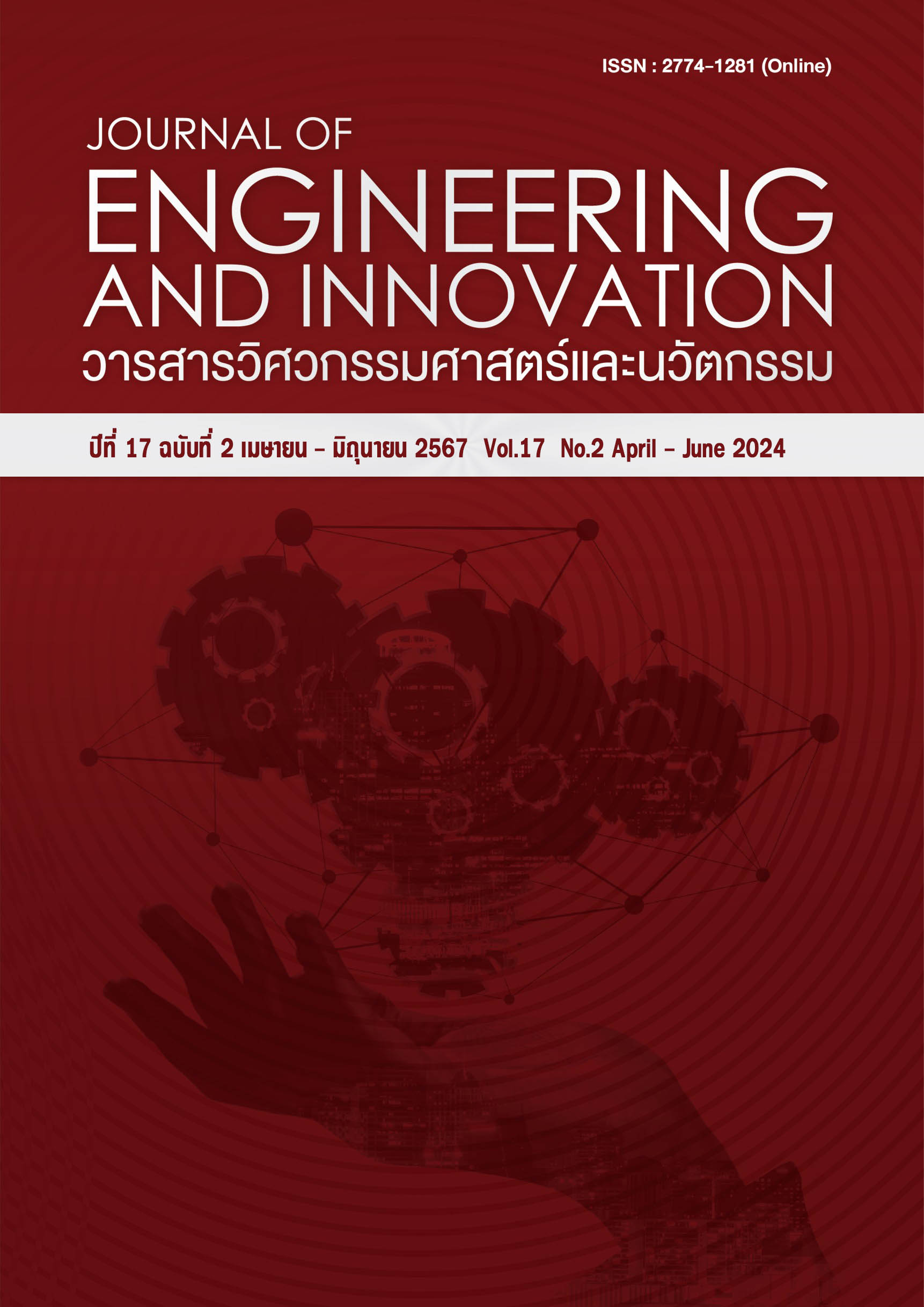Evaluation of thermal conductivity and compressive strength of cellular lightweight concrete with various heating temperatures
Main Article Content
Abstract
Cellular lightweight concrete is mortar mixed with preserved air bubbles or foam liquid distributed in concrete instead of coarse aggregate in order to reduce the concrete unit weight. The properties of cellular lightweight concrete vary with unit weights. Concrete with great amount of bubbles given high porous and light weight provides low thermal conductivity. Cellular lightweight concrete with unit weights of 1600 and 1800 kilograms per cubic meter using water to cement ratio of 0.45 and 0.55 and sand to cement ratio of 2:1 and 3:1 were designed and produced for the study of thermal conductivity and the remained compressive strength after heating at various temperatures. The results are as follows: (1) the thermal conductivity coefficient ranged from 0.164 to 0.255 watts per meter Kelvin and (2) the average remained compressive strength after heating at temperature of 200, 400, 600, 800 and 1000 degrees are approximately 91, 76, 52, 28 and 17 percent, respectively.
Article Details
References
Narayanan N. and Ramamurthy K. 2000. Structure and properties of aerated concrete: a review. Cement & Concrete Composites. 22: 321-329.
Fouad H. Fouad. 2006. Cellular concrete. Joseph F.Lamond and James H.Pielert (eds). In: Significance of Tests and Properties of concrete and concrete- making material, p561-569. ASTM International, West Conshohocken, PA.
Nambiar E.K.K. and Ramamurthy K. 2007. Air void characterisation of foam concrete. Cement and Concrete Composites. 37: 221-230.
Shetty M.S. 2000. Concrete Technology: Theory and Practice. S.CHAND & COMPANY. Ram Nagar, New Delhi.
Gambhir M L. 2013. Concrete Technology: Theory and Practice, 5ed. McGraw Hill Education (India) Private Limited, New Delhi.
มอก. 60-2516. มาตรฐานคอนกรีตบล็อกเชิงตันรับน้ำหนัก. สำนักงานมาตรฐานผลิตภัณฑ์อุตสาหกรรม. กระทรวงอุตสาหกรรม. 2516.
บริษัทปูนซิเมนต์ไทยอุตสาหกรรม. 2548. ปูนซีเมนต์และการประยุกต์ใช้งาน พิมพ์ครั้งที่ 2 293 หน้า.
www.dconproduct.com สืบค้นเมื่อวันที่ 1 พ.ย.2565
www.qcon.co.th สืบค้นเมื่อวันที่ 1 พ.ย.2565
อิทธิเชษฐ์ อุตะธีรวิชญ์ และ ธนภร ทวีวุฒิ. 2553. คุณสมบัติการใช้งานคอนกรีตมวลเบาแบบเซลลูล่า. การประชุมวิชาการวิศวกรรมโยธาแห่งชาติครั้งที่ 15 12-14 พฤษภาคม 2553 ณ โรงแรมสุนีย์ แกรนด์ แอนด์ คอนเวนชั่น เซ็นเตอร์ จ.อุบลราชธานี.
ปภาวิน สินรัมย์ และ ธนภร ทวีวุฒิ. 2555. ช่องว่างอากาศและคุณสมบัติการใช้งานคอนกรีตมวลเบาแบบเซลลูล่า. การประชุมวิชาการวิศวกรรมโยธาแห่งชาติครั้งที่ 17 9-11 พฤษภาคม 255 ณ โรงแรม เซ็นทารา แกรนด์แอนคอนเวนชั่นเซ็นเตอร์ จ.อุดรธานี
คณะกรรมการกฤษฎีกา ราชกิจจานุเบกษา เรื่อง ค่าสัมประสิทธิ์การนำความร้อนของวัสดุ หน้า 15 เล่ม 113 ตอนพิเศษ 21 ง ลงวันที่ 17 กรกฏาคม 2539
Kosmatka Steven H., Kerkhoff B., and Panarese William C. 2003. Design and Control of Concrete Mixtures, 14ed. Portland Cement Association.
Rodriguez A., Pedraza M., Luciano J. and Constantiner D. 1999. Mixture Design Optimisation of Cellular concrete. Ravindra K Dhir and Neil A Henderson. (eds). In: Specialist techniques and materials for concrete construction. Thomas Telford Publishing. London.
ธนภร ทวีวุฒิ, นท แสงเทียน, วิวัฒน์ พัวทัศนานนท์, อิทธิพงศ์ พันธ์นิกุล. กำลังรับแรงอัดของคอนกรีตมวลเบาแบบเซลลูล่า. วารสารวิชาการวิศวกรรมศาสตร์ ม.อบ. 2563; กรกฎาคม-ธันวาคม. 13(2): 88-101.
ASTM C128 - Standard Test Method for Specific Gravity and Absorption of Fine Aggregate
การวิเคราะห์ขนาดคละมวลรวมละเอียด Sieve Analysis of Fine and Coarse Aggregates and Maximum Size of Aggregate (ASTM C 136 – 96a)
Neville Adam M. 2003. Properties of Concrete. Fourth Edition. Pearson Prentice Hall. England.
Kunhanandan Nambiar E.K. and Ramamurthy. K. 2006. Influence of filler type on the properties of foam concrete. Cement & Concrete Composites. 28 475–480.
Falade F., Ikponmwosa E. and Fapohunda C. 2013. A Study on the Compressive and Tensile Strength of Foamed Concrete Containing Pulverized Bone as a Partial Replacement of Cement. Pak. J. Engg. & Appl. Sci. Vol. 13, p. 82-93.
ASTM C 177 Standard Test Method for Steady-State Thermal Transmission by Mean of The Guarded Hot Plate
มอก. 409-2525. มาตรฐานวิธีทดสอบความต้านแรงอัดของแท่งคอนกรีต. สำนักงานมาตรฐานผลิตภัณฑ์อุตสาหกรรม. กระทรวงอุตสาหกรรม. 2525.

